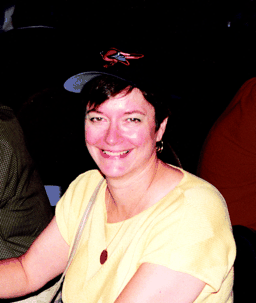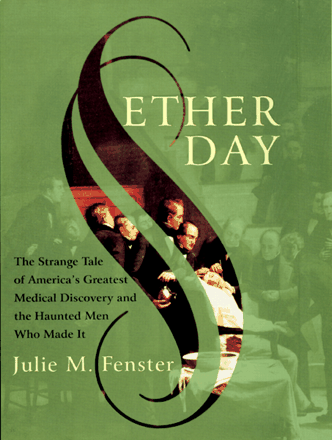Ether Daze
- Christine K. Carrico, PhD, Executive Officer of ASPET
Ether Day: The Strange Tale of America’s Greatest Medical Discovery and the Haunted Men Who Made It. Julie M. Fenster. New York: HarperCollins; 2001. 278 pages. $24.00. ISBN: 0060195231
Before October 16, 1846, the day that ether was demonstrated as an anesthetic in the operating room of Massachusetts General Hospital, it had been necessary for those undergoing surgery to be physically restrained, an ordeal that contributed to the demise of many patients. In Ether Day, Julie Fenster tells the story of the events leading up to and flowing from the “Ether Dome” on that fateful Friday in 1846. The discovery and demonstration of ether as an anesthetic are distinct issues that converge into a fascinating story, filled with compelling characters and fraught with controversy.
Credit for discovering the anesthetic properties of ether was claimed by Dr. Charles Jackson, an eminent Boston chemist and geologist, although he never used ether as an anesthetic. William Thomas Green Morton, a dentist, medical student, and confidence man, actually devised a delivery apparatus and demonstrated the anesthetic effects of ether in the operating theater of Massachusetts General Hospital. Nevertheless, both men felt entitled to total credit for the discovery of its usefulness, and a feud over the claim to credit lasted for decades, involving not only the US Congress but also the French Academy of Sciences. The story is further complicated by Horace C. Wells, a dentist, inventor, and entrepreneur, who argued that he should get credit because he had recognized the anesthetic effects of nitrous oxide several years earlier.
The discovery of nitrous oxide was actually made a hundred years earlier, in 1772, by Joseph Priestly, and it was first used two decades later by Sir Humphrey Davy to induce sleep. Oddly enough, even though Davy noted that the compound might be used “with advantage during surgical operations,” his surmise never prodded anyone to try nitrous oxide as a surgical anesthetic. Instead, it became widely known as an entertainment gas, with opportunists staging whole expositions to demonstrate its elevating effects and allowing spectators to make fools of themselves. One such opportunist was Samuel Colt, who used the money he made to develop and produce his pistol. Dentists, who weren’t quite doctors in the early nineteenth century, were the first to use nitrous oxide and ether to reduce pain. Still, prior to William Morton, no one seemed to make the leap of reason that these chemicals might be used to reduce or eliminate the frequently excruciating pain of surgery.
William Morton was a young entrepreneur of the worst kind, who left broken hearts and unpaid bills in numerous cities in the East and mid-West before he made the acquaintance of Horace Wells of Hartford, Connecticut, and decided to learn dentistry. It was from Wells that he learned about nitrous oxide. Morton subsequently moved to Boston, where he cultivated the acquaintance of Charles Jackson from whom he may have learned about ether. Morton attempted to patent the use of ether as an anesthetic, but this effort was doomed to failure once the story of its amazing effects got out. Morton spent much of his life trying to get the US government to pay him for its use of ether during the Civil War. And despite the fact that Charles Jackson despised William Morton, he was listed on the patent as co-discoverer. Jackson on the other hand spent his later years petitioning the French Academy of Sciences to recognize him as the discoverer of ether’s anesthetic properties. Wells, on the other hand, simply gave up dentistry and moved on to other unproductive activities. The story of these relationships is one of egos, charlatans, entrepreneurship, missed and snatched opportunities, and dashed hopes. It is interesting that all three men were certifiably insane when they died.
Part of the interest in this story lies in the peripheral characters who were drawn into the battle: John C. Warren, founder of Massachusetts General Hospital; Samuel Morse, whom Jackson blamed for stealing his idea of the telegraph; Ralph Waldo Emerson, brother-in-law of Charles Jackson; and Oliver Wendell Holmes, consulted for a more descriptive name than “etherisation.” Jackson, certainly, and Morton to a certain extent, habituated the fringes of Boston society, which in the nineteenth century was the cultural center of the US.
Julie Fenster has prodigiously researched the lives of the individuals involved in her book and has complemented the story with many photographs of the characters. Unfortunately, her telling of the tale would have benefited greatly from better editing. The book leaps around in time, goes off on tangents that have nothing to do with the story, and, often within a given page, repeats itself. These narrative inconveniences can make it difficult to enjoy the story of the swindlers, egomaniacs, and scalawags who were responsible for bringing the blessed relief of surgical pain to the masses.
Julie Fenster is a columnist for American Heritage and a contributor to the New York Times.

- © American Society for Pharmacology and Experimental Theraputics 2002




